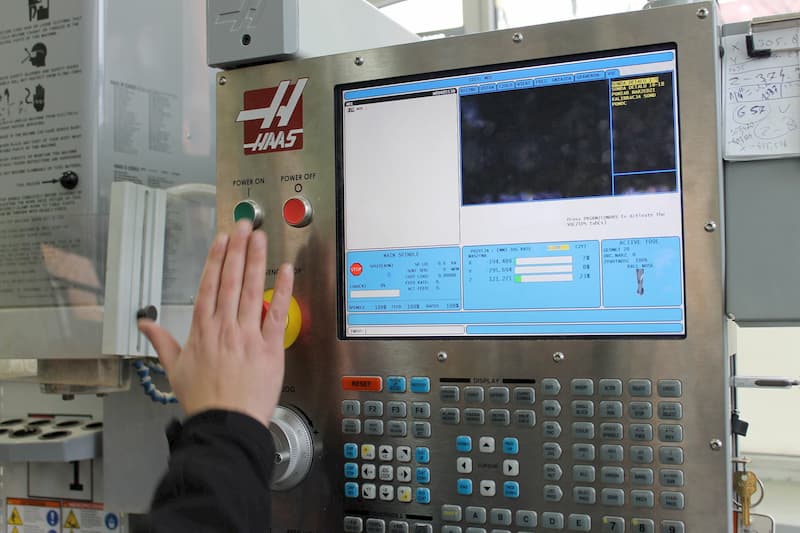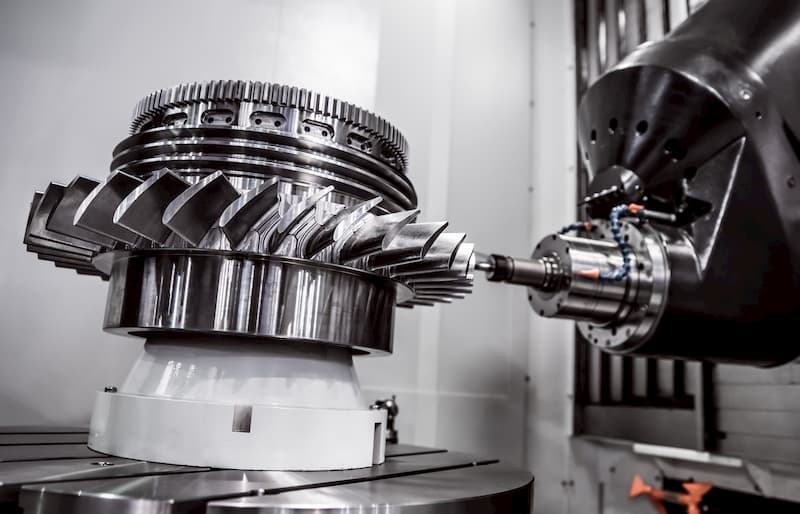CNC machining cost calculations can seem pretty complicated. There are a lot of factors to take into account, making the final cost assessment a little more difficult compared to other fabrication methods.
For example, our own platform could calculate laser cutting prices in seconds already in 2017, taking material usage, cutting time and geometry into account. Doing the same for CNC milling and turning services is considerably more difficult as there are a lot more variables involved. But in 2021, automated CNC pricing was introduced to the platform as well and since then, we’ve kept on developing and tweaking our pricing algorithms to offer more and more competitive prices, in line with the current market situation.
In this article, we will take a closer look and explain what components make up CNC machining costs.
Quick Introduction to CNC Machining
CNC machining is a subtractive method for producing parts. This means that the operations remove material. It is possible to use it for creating the necessary parts from a variety of materials, including metals, plastics, etc.
The first sentence pretty much encompasses the essence of CNC machining, differentiating CNC turning and milling from other manufacturing methods that use computer numerical control. Turning and milling both start with a larger block of material, carving away at it to arrive at the desirable result.
Calculating Machining Costs
CNC machining price comprises of a few different aspects. Namely, labour & machine costs, tooling, tool wear, material and setup.
Taking all these into account may be difficult, as a precise assessment for each category is hard to get to. At the same time, there is no way to turn a blind eye to any of these components of the final price.
Time Is the Basis
Almost all of these parameters are in direct relation to time, with material being the only exception. Before we can put a price tag to any of them, we need an assessment of time consumption. And this is also the most difficult part of the whole process.
Pretty much all proper workshops possess some kind of computer-aided manufacturing programs. The most basic ones are CAD-CAM software that have capabilities for both design and CAM at the same time.
CAM programs need input in the form of 3D models. Based on these, they generate the whole manufacturing process, using tool libraries and information provided by the workshop owner about the specifics of their machinery.
CAM software creates G code that is responsible for guiding the cutting heads, spinning speeds, etc. Basically everything related to the production side of the process. M Code determines tooling changes, use of coolant, etc. All this comes with time estimations for each operation.
Therefore, we can see how long the whole process takes, how much work a single tool does, how many tool changes occur, and so on. The machine operator can also adjust the program to better fit his machinery or when he sees a better way to produce the parts.
But the important part is here – CAM software can give an assessment of the time required for making a part.
And it is all based on 3D models. If you do not have them, the price quote often relies on a mix of using Excel sheets and common sense combined with previous experience. And while bringing intuition into the frame may seem hugely inaccurate, it is not.
That is also the reason why automating the whole pricing process is possible through AI. Using the part parameters and comparing them to previous works, their production times and costs can bring us to a fairly optimal price point.
- Personal account manager
- Quality assurance
- Payment terms for companies
- On-time delivery by Fractory
Machine Costs
The clients have to pay back the purchase price of the machinery to the shop. The average machine shop takes 5000 hours as the basis for paying back the initial investment. Even the prices at a marketplace for used CNC machinery can get pretty high, although these machines are probably less cost-effective because of the speed limitations and less automation.
So let’s say that the machining time for your part is 0.5 hours. Then the first step towards the final price is adding 1/10000th of the machine price to the production cost.
The standard hourly price for 3-axis machining is around £30. Multi-axis costs more, reaching 3x the price. But depending on your part geometry, the time savings can be considerable with these more advanced CNC centres.
Labour & Setup

The first point, of course, is your own or the designer’s time. Then comes the manufacturing engineer. He will review your design for producibility. If your designed parts have flaws, he will have to come back with suggestions for changes. Expertise such as that will come with a price.
Next comes the machine operator. He spends time setting up the machine for a custom CNC job and making sure that everything is performed in a manner that results in a great result.
Each part needs a new setup, which is why bulk production significantly reduces the price per part.
Material Costs
CAD programs can do very accurate mass calculations for parts based on the volume of the part and the density of the material. All you need to do is select the right material from the drop-down menu.
However, CNC machining costs include more material than the final product itself displays. As a subtractive manufacturing method, there is quite a bit of scrap.
A machine for CNC milling starts the work with a block of material. Therefore, the general dimensions plus a little bit extra is necessary to produce the final piece.
When it comes to turning, the starting point is usually a round stainless steel bar. It is important to note that while your part has specific dimensions and the “extra bit” would not have to be significantly larger than the general dimensions of the final product, there are standard sizes for materials.
For example, let’s say you want to produce a shaft that has a diameter of 33mm at its largest. The nearest standard round bar is 35 mm. Therefore, this is the raw material for the CNC machined part and also extra turning operation is necessary to reach the base measurements.
Change of Tools and Tool Wear
As already mentioned, the CAM software decides which milling tools to use for producing your part. This depends on your tool library and the manufacturing engineer can make changes if necessary.
It is not uncommon that a specific job may require buying a separate tool for this purpose only, as is also the case with metal bending services. While the tools will stay at the workshop, the client may have to pay a little extra, if this tool is specific enough to not find much use later.
Also, based on the time calculations and tool lifetimes provided by the documentation, tool wear is taken into account. The customer has to cover these costs.
Lastly, a change of tools is usually necessary for creating a part, unless it is very simple. While modern CNC machining centres may have live tooling possibilities, not every machine shop has access to these. Thus, this adds another step of manual labour into the whole process, reflected in the final machining price.
Conclusion
As you can see, there are a lot of elements to account for when calculating CNC machining costs. This is why many vendors take their sweet time before coming back with a quote.
Making a mistake here and there can either result in a price that is not profitable for the manufacturer or just overpricing, not bringing in the job.
We, here at Fractory, have continued to hone our pricing algorithms over the years and we’re offering competitive instant quotes for prototyping and low-volume orders under £2000. For larger orders, our experienced sales engineers will go over the project specifics manually to be able to provide the best prices at requested tolerances and/or suggest alternative more cost-effective design and manufacturing options.



